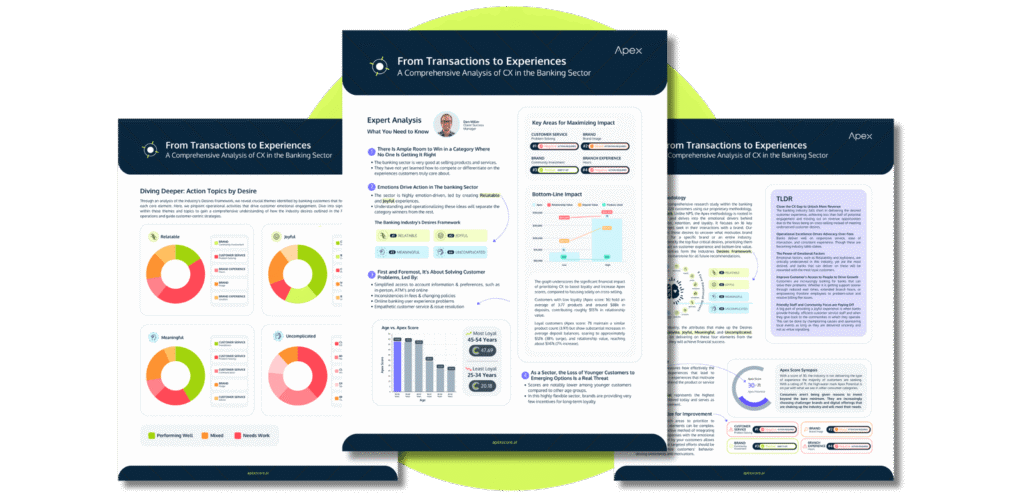Remember that time you called or went to your bank and had such an incredible experience that you told everyone you knew that they need to switch to your bank as quickly as possible?
…what? You don’t remember that?
Of course you don’t… it never happened.
Don’t worry, it’s not just you. It’s everyone. And it’s a big problem.
We know this because, in collaboration with Schlesinger Group, we published our 2022 US Banking Industry Loyalty Report. In speaking with over three-thousand customers of some of the biggest legacy and fastest growing challenger banks in America, we knew we’d find some hits and misses in the sector, but wow… the misses are everywhere!
We’re all wading through a particularly troubling time, especially if keeping some kind of plan for a healthy financial future is a priority for you. Soaring inflation, rising interest rates, dizzying market fluctuations, and crumbling consumer confidence, all spurred on by the endlessly long tail of Covid and the horrific war in Europe are all conspiring to make life exceedingly complicated, frustrating, and expensive.
It’s against this wake-me-when-it’s-over backdrop that we talked to banking customers using our Apex loyalty tracking platform to understand what’s working, what’s not, and where the industry can’t afford to leave customers hanging any longer.
In looking at 10 of America’s very largest and most established banks (including the likes of Capital One, Bank of America, Citibank, Chase, and Wells Fargo), we see extremely varied loyalty scores, with a 37% spread from the best to worst.
When we assessed the same loyalty scores among 10 of America’s fastest-growing challenger banks (such as Chime, N26, Axos, and Varo), we saw a stark difference, with scores that were, on average, 21% higher than the large legacy banks. One brand in particular, SoFi, appears to be running away with delivering the best banking experience around.
In this hyper-competitive, increasingly fragmented, and highly emotionally-charged category, delivering anything looking like a middling experience could spell disaster. Here are three key findings that stand out as the best starting points.
1. Say What You’ll Do, and Do What You Say
75% of consumers said a Predictable relationship with their banks is the most important driver of loyalty. Say what you do, and do what you say. In particular, don’t try to be everything to everybody. Pick your “lane”, and excel at it.
One of the most transformational outcomes of the COVID-19 pandemic was how people had to entertain entirely new ways of buying, sharing, connecting, and engaging. The inability for many to have in-person, human-to-human interactions forced businesses to rethink their product and service delivery, which in turn pushed consumers to change their ways. Habits were forced to evolve, and brand relationships were tested.
In the early months of the pandemic restrictions, as we saw in the banking vertical findings of our May 2020 Covid Syndicated study, Joy (79% desired) was a leading desire, along with Honest (82%). People were frustrated with their lives being turned upside down, and they wanted brands to put a smile on their face while telling them the simple truth.
To be viewed as Predictable, your customers should feel at ease knowing what to expect when interacting with your brand. This predictability offers protection against intolerance of uncertainty, a common characteristic that drives people to avoid the unknown.
One year later, in the Spring of 2021, our follow-up Covid Syndicated study showed how things had changed, with both Dependable (84% desired) and Responsive (84% desired) becoming the leading attitudes people wanted from their financial institutions. Now, more than two years after the beginning of the pandemic, things have changed once again.
Two+ years of pandemic life have pushed people to reevaluate much of their life and finances, and the support of their banks is among the most important. People expect you to deliver what you promise, and when you don’t, they are prepared to explore options rather than just settle. The successful bank brands are responding, and in the process, redefining what a predictable experience can be.
Interestingly, this desire holds the same importance whether you’ve done business with your bank for 3 years or 30 years.
Recommendations for Action
- Train Customer Service Reps to Take Control: Focus on hiring and training “controller” reps who are confident, proactive, and can take charge during customer interactions. This approach helps customers feel more at ease.
- Provide Clear Guidance: Ensure that customer service reps offer clear, concise instructions during interactions to reduce uncertainty. This makes customers feel more confident and secure.
- Identify Take-Control Evangelists: Scan your frontline staff for individuals who naturally take control of situations and provide reassurance. Encourage and empower them to lead customer interactions.
- Implement a Problem-Solving Framework: Develop a framework like Ritz-Carlton’s MR. BIV (Mistakes, Rework, Breakdowns, Inefficiencies, and Variations) to empower customer service reps to solve problems independently.
- Empower Reps to Make Decision: Allow your customer service team to resolve issues on their own, without requiring managerial approval for every decision. This fosters quicker resolutions and builds customer trust.
- Foster Confidence Through Rep Behavio: Encourage customer service reps to demonstrate confidence and authority in their communications, activating customer trust and assurance through the concept of mirror neurons.
- Focus on Consistency in Service: Ensure that all customer interactions follow a predictable pattern, reinforcing a sense of security and trust in your brand.
By implementing these strategies, banks can create a more predictable, reliable experience for their customers, reducing uncertainty and fostering loyalty.
2. Understand and Overdeliver on Emotional Expectations
It’s about putting customer needs at the center of every conversation, and treating them in an Honest and Respectful manner, whether that is technology assisted or not.
In general, customers expect a more rational than emotional relationship with their banks. Whether they are big-name legacy brands, local independent brands, or upstart challenger brands, customers desire an experience that excels in product delivery and is very practical. What is it that separates challenger banks from the rest? Their ability to over-deliver an emotional experience.
Apex measures eight specific emotions that drive customer behaviors, and according to this study, seven of them are met or over-delivered by challenger banks, versus only two for legacy banks. Customers feel that challenger banks deliver Honesty 20% higher than they expect, and Respect almost twice as much (97% higher) as desired. This is in the face of most of these relationships being nurtured entirely online, with brands that use technology and AI tools to deliver much of the customer experience.
Local, independent banks also fare well in delivering better honesty (2X higher) and respect (+50% higher) in customer relationships, suggesting the answer is not just smarter technology.
To be felt as Honest and Respectful, your organization’s leaders must be willing to have tough conversations, be vulnerable and ensure that people always feel in the loop, even if the future is uncertain.
Recommendations for Action
- Encourage Leadership to Have Tough Conversations: Train leaders to engage in open, honest discussions with customers, even when addressing difficult or uncertain topics. Transparency builds trust and demonstrates respect.
- Be Vulnerable and Open About Uncertainty: Ensure that customers are always in the loop, even if the future is uncertain. Share both the good and bad news openly, signalling honesty and respect for their involvement.
- Treat Customers as Valued Individuals, Not Transactions: Recognize and value customers beyond their financial contributions. Show that your organization cares about their well-being, reinforcing a relationship built on respect and dignity.
- Foster a Sense of Community Among Customers: Create opportunities for customers to connect with your brand, similar to Rapha’s cycling club. Host events, activities, or forums where customers can share experiences and build a shared identity.
- Incorporate Rituals and Symbols to Build Identity: Use branding, symbols, and shared rituals to create a strong sense of belonging and connection among your customer base. This helps establish a deeper emotional bond tied to respect and loyalty.
- Build Respect by Offering Opportunities for Personal Growth: Provide experiences or resources that help customers achieve personal milestones or develop skills, enhancing their sense of dignity and moral worth.
- Continuously Demonstrate Honesty and Respect in Every Interaction: Train all staff to approach customer interactions with respect and transparency. Empower them to make decisions that reinforce your brand’s values of honesty.
By implementing these actions, your organization can create a culture where customers feel respected, valued, and connected, leading to stronger loyalty and trust.
3. The Small Things Can Deliver the Biggest Impact
Finding ways to reduce complexity in an industry that is prone to long, complicated documentation and layers of process, can drive perceptions of innovation as much as any new technology. Sometimes a rethink of the small moments in a customer’s journey can have the biggest impact.
Customer loyalty is earned, not demanded or bought. And there are no magical solutions that trigger loyalty for life. Brands must work hard each and every day to nurture the kind of relationships that translate into lasting business success.
When customers say, “Here’s what I need from you if you want more from me,” the brands that are winning listen closely, act accordingly, measure their impact, and get right back to listening to close the feedback loop.
Sometimes, big ideas can win the day and entice people into the brand tent as newly won customers. But more often than not, it’s the smaller, everyday moments between a customer and a brand that sow the seeds for stronger loyalty. This is particularly true right now, in the banking industry, among legacy brands.
To be believed as Forward-Thinking, you need to think of brand innovation and marketplace introductions that can directly impact the customer’s perceptions of how much your product or service is worth. If delivered well, these innovations can cause customers to experience a release of dopamine, making it feel like there’s the possibility of more rewards just around the corner.
The perception of a brand being Forward-Thinking is both an issue and an opportunity for these top 10 banks. To be viewed as forward-thinking, a brand must create products or services that are both original and meaningful. This does not necessarily mean these brands have to offer technology solutions that are groundbreaking. This, as we know, comes with high costs. It simply means they need to lean in on all the other emotional and rational attitudes that customers desire in a relationship, to create and deliver experiences that are perceived as distinct, because they make the small things easier, smarter, simpler, and more customer-centric.
Ironically, sometimes the best way to be forward-thinking is to be backward-thinking — to wax nostalgic and go back to a simpler time, before the newfangled technologies, when transactions were interactions, and customer-business relations were human-to-human connections.
Recommendations for Action
- Focus on Innovations that Enhance Customer Experience: Prioritize innovations that directly improve the customer experience, rather than tech enhancements for their own sake. Innovations should add value, making customers feel like they are receiving tangible benefits.
- Align Innovation with Perceived Value: Ensure that every new product or service enhancement increases the perceived value of your offerings in the eyes of the customer. These improvements should go beyond operational efficiency and directly impact the customer’s experience.
- Leverage Subtle Trends: Develop strong observation skills within your team to identify subtle market trends that competitors haven’t noticed yet. Focus on changes that may seem small but can significantly influence customer perceptions of your brand as forward-thinking.
- Incorporate Visualization Techniques in Daily Routine: Encourage employees to practice visualization techniques to enhance their observation skills. Writing down specific, tangible descriptions can help them internalize new ideas, leading to more creative and original thinking.
- Promote a Psychologically Safe Work Environment: Foster a work environment where employees feel safe to share ideas and experiment. Psychological safety is linked to higher levels of employee innovation, which can drive customer-centric improvements.
- Encourage Flexible Thinking and Creativity: Invest in training programs that boost employees’ creativity and flexibility. This can help your team be more adaptable to changing trends and capable of introducing meaningful innovations.
- Tie Innovations to Positive Customer Emotion: Focus on creating innovations that generate excitement or a sense of reward for customers. When customers experience something new that enhances their experience, it can trigger positive emotional responses, fostering loyalty.
By following these recommendations, your brand can cultivate a reputation for being forward-thinking, innovative, and customer-centric, setting you apart from competitors.
What's the Summary?
While continuing to deliver on intuitive and predictable experiences, the banks that are winning are finding ways to emotionally connect and deliver much-desired innovation through thoughtful touchpoint delivery. The rest are simply getting left behind.
Full Industry Analysis Download
Unlock customer segmentation insights and strategic priorities for staying ahead in today’s market. Elevate customer experience and fuel business growth. Download now to begin your journey to banking excellence!





